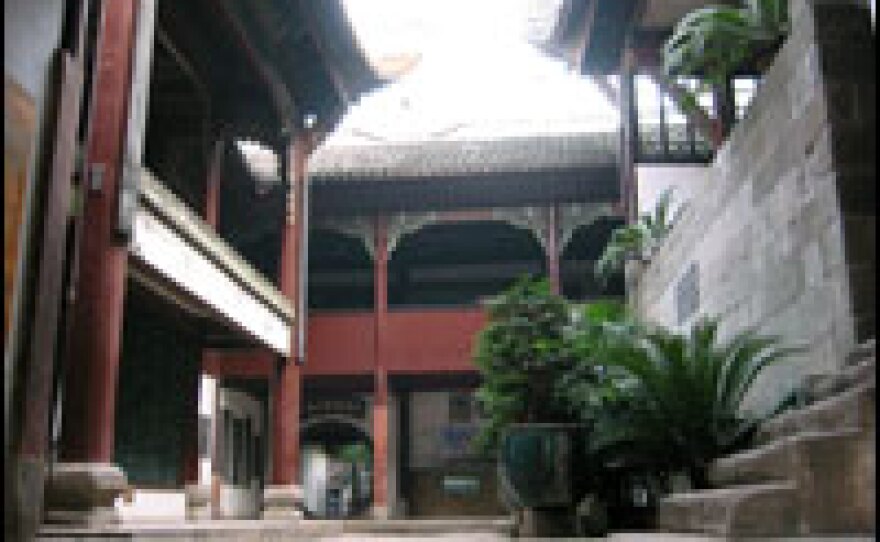


As the reservoir from China's Three Gorges Dam reaches its maximum height this year, it will inundate more than 400 square miles of land.
More than a million people are being moved along with homes, schools and hospitals. But this part of China is home to a unique culture, not all of which can be moved.
Some parts of the culture are being saved — and some are being lost.
Historic Sites at Risk
An impressive Stone Treasure Fortress dominates the shoreline of the reservoir in the county of Zhongxian. There aren't any fortifications any more. The main structure is an early 18th century, multitiered pagoda with curly eaves.
It's perched on a cliff looking out over the Yangtze River. On the front of the gateway is a water level marker that says 175.1 — the number of meters above sea level and the level to which the waters will rise when the dam is completed.
This was once the stronghold of the Deng clan, and an ancient village once sat at the feet of the fortress. The village has now been razed and its residents relocated.
One of them is Deng Shuhua, who sells drinks and souvenirs outside the site. He recounts a local legend about how the place got its name.
"The legend goes that the Goddess Nuwa was fixing a hole in the sky. She was carrying some stones in a basket, when one of them dropped out, fell on the river bank and became this mountain. That's the 'Stone Treasure,'" he says.
New Defenses for an Ancient Fortress
Nearby, workers cut and chisel stone, part of an effort to protect the fortress from the rising waters.
Engineer Qiu Guogui works close to the site. He says the fortress will be surrounded by 222 concrete and steel pillars — and a wall connecting them will keep the river from submerging the fortress.
"The fortress will become an isolated island, accessible either by boat or a connecting bridge," Qiu says.
Downriver from the fortress is a temple dedicated to a third century general of the Three Kingdoms period, Zhang Fei.
"The entire temple was moved with the aim of preserving it in its original form," says Wu Qiongying, a tour guide. "Every stone and brick you see here was removed piece by piece, numbered, moved and then used to reconstruct the temple."
Saving a Drowning Culture
After more than a decade, the effort to rescue the cultural heritage of the Three Gorges is in its final phase. Far less money has been spent on cultural preservation than on environmental protection and relocating residents.
Tang Yuyang of the Beijing Institute of Civil Engineering and Architecture has been involved in the rescue effort. She says that while some important sites have been moved or rebuilt, a lot of intangible culture is being lost.
"The people of the Three Gorges no longer exist," she says. "What I mean is that the environment, the local customs, the feeling is gone. Before, locals carried things in baskets on their back, climbing steep stairways up the hillsides to get to the towns; now it's all highways. It's not just the physical sites that are at issue."
Downriver from the temple is the City of the White Emperor, where the founder of one of the Three Kingdoms died. Five centuries later, one of China's most famous poets, Li Bai, mentions it in a poem about a journey through the river's fast and treacherous waters.
Zhang Taichao, former journalist, author and official, notes that with the building of the dam, the classic descriptions of the Three Gorges in Chinese literature and art no longer apply.
"The natural landscapes described by our ancient poems will disappear," he explains. "Future generations, including my daughter, will not get to see this magnificent scenery that we Ba people are so proud of."
Theme Park at an Ancient Site
The ancient village of Dachang was once full of picturesque cobbled streets and ancient wooden temples. Now the village had been reconstituted uphill as a sort of theme park. Workers lay new cobblestones, as men dressed up as Qing Dynasty soldiers guard the gates.
"We feel very proud because the government has spent all this money to move the village," says village employee Lei Haoming. "This means that it will not be submerged, but preserved for people to see in the future, and so we feel that our culture has been well preserved."
As is often the case in China, replication is often confused with historic preservation. The main difference, of course, is that no actual residents live here anymore. They've been relocated so as to facilitate the business of separating tourists from their money.
Losing the Landscape
Traveling through the Three Gorges, it seems that almost every rock has a name, every mountain has a legend. One of the few people who documented the region's natural wonders before they were inundated is local photographer Wang Fengyun.
"The grooves on this rock were formed by people using ropes to pull boats against the current," Wang says as he points out a photo in a book of his work. "Some of these grooves are more than 3 feet deep. This rock here looks like a wolf. It reminds us that the people of Ba have plucked their survival from the wolf's jaws.
Scholar Tang Yuyang says that what makes the culture of the Three Gorges special is the interrelation between humans and this unique landscape.
The dam, Tang says, has irreversibly wrecked that relationship.
"Just because we possess this technological power, we should not let it overshadow our relationship with the mountains and rivers," she says. "We should emphasize the power of nature."
In fact, the problems of cultural preservation, economic development and urbanization in the Three Gorges can be found all over China. It's just that the building of the dam is forcing the changes on people faster here than elsewhere.
Some people say that the resourceful people of this ancient region will someday create a new and unique culture. Maybe so, but for now all that is clear is that a rich cultural heritage is being submerged beneath the reservoir's waters, perhaps forever.
Copyright 2022 NPR. To see more, visit https://www.npr.org. 9(MDAzMjM2NDYzMDEyMzc1Njk5NjAxNzY3OQ001))







